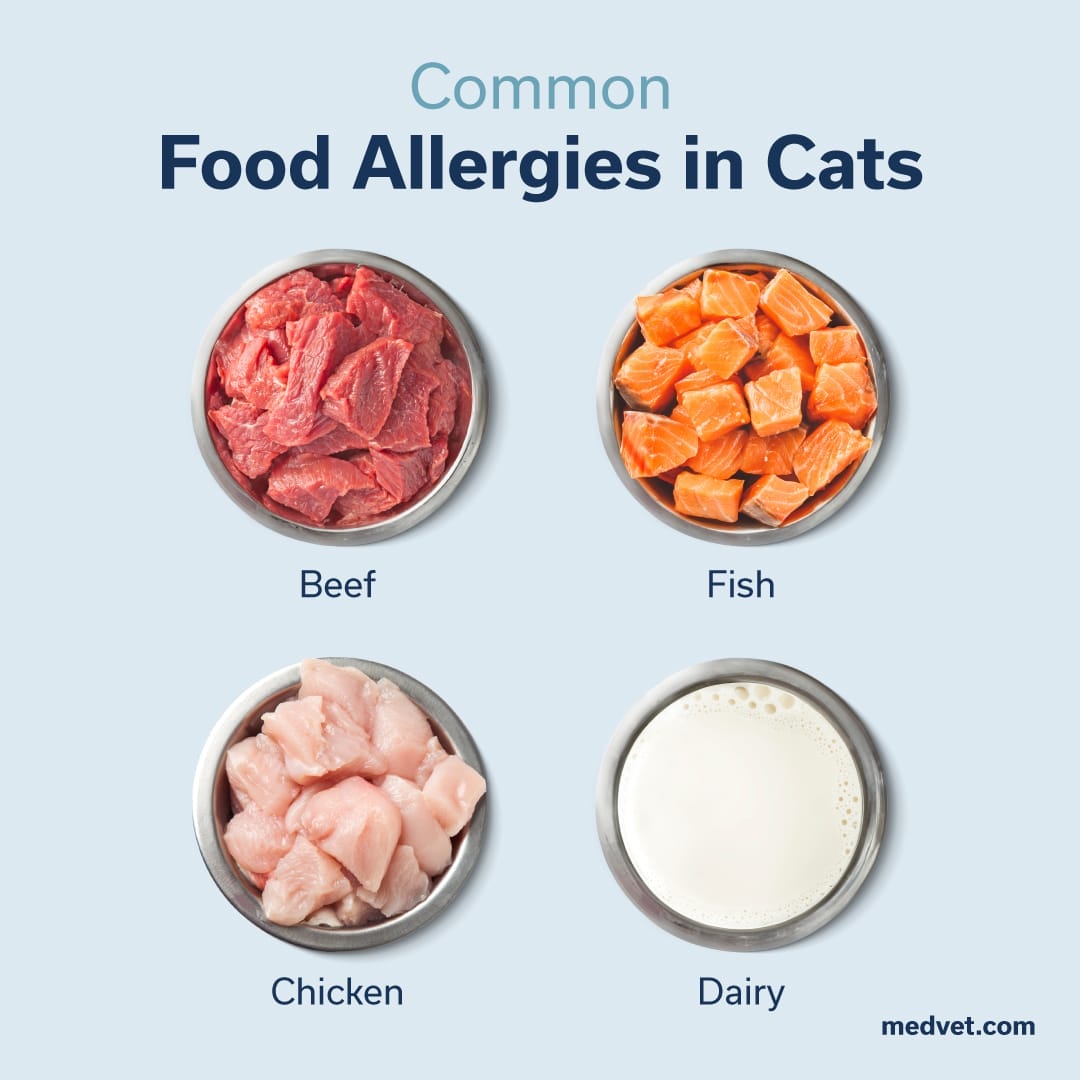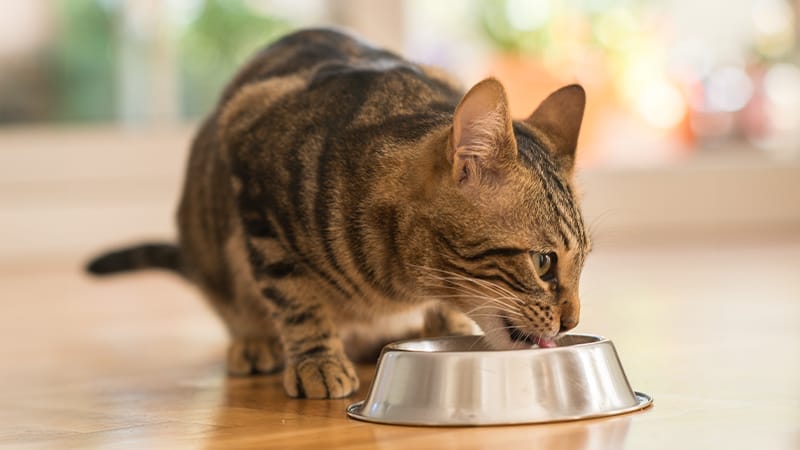Food Allergies in Cats: Does My Cat Have Food Allergies?
Cats can develop allergies to foods they have been consuming for a long time. A food trial can identify your cat’s allergen.
When a cat’s immune system repeatedly reacts adversely to a specific ingredient in their food, they have developed a food allergy. But how do you know which ingredient is causing your cat’s allergic reaction and what can you do about it? Read on to learn more about food allergies in cats, the signs your cat may be allergic to their food, how veterinary dermatologists diagnose food allergies, and what you can do to manage your cat’s food allergies.
What Causes Food Allergies in Cats?
Food allergies in cats, also known as cutaneous adverse food reaction (CAFR), are among the most common allergies felines experience. It occurs when your cat’s immune system overreacts and produces antibodies to a protein or complex carbohydrate in their food, causing inflammation in their body. Because it takes time for your cat’s body to develop antibodies to an ingredient, they can develop allergies to foods they have been consuming for a long time.
While the exact cause of food allergies is still unknown, it is believed to be a combination of genetic predisposition and exposure to specific allergens.
Common Food Allergies in Cats and Signs
Although cats can develop allergies to any protein or carbohydrate they have been exposed to, the most common food allergies for cats are beef, fish, chicken, and dairy products.
Less commonly, they can have allergic reactions to wheat, corn, dairy, lamb, egg, barley, and rabbit.
The most common sign of food allergies in cats is chronic itching, skin lesions, and loss of hair. The itching typically affects areas such as the face, ears, belly, groin, armpits, legs, and paws.
Because it takes time for a cat’s immune system to build antibodies against certain proteins or carbohydrates, the signs your cat is experiencing an allergic reaction will also take time and likely intensify.
In addition to chronic itching and skin inflammation, some cats may also develop recurrent skin and ear infections. Gastrointestinal signs, like vomiting, diarrhea, and scooting may also be present in some cases. Additionally, some cats may develop inflammatory bowel disease.

How Do You Know if Your Cat Has Food Allergies?
The most reliable method for diagnosing food allergy (CAFR) in cats is an elimination diet trial, which involves feeding a diet that does not contain any proteins your cat has been previously exposed to. This trial can take at least eight weeks and should be supervised by a veterinarian. During the trial, it is crucial to eliminate all other treats, supplements, and edible products to ensure accurate results.
Test diets are either a “novel” protein diet (no previous exposure to that protein) or hydrolyzed protein (protein that has been modified so that it is not allergenic). Manufacturing, handling, and packaging of the diet is also important. There are not many over-the-counter diets that meet the criteria for an appropriate food trial. There are dry and canned prescription diets available for food allergy patients. Home cooking may also be needed in some cases.
While there are blood, saliva, and hair “tests” commercially available to “diagnose” food allergy in pets, they are not recommended as they are not accurate or reliable.
What Happens During a Food Trial for Cats
Your veterinarian or veterinary dermatologist will guide you on how to successfully administer a food trial for your cat. Only feed your cat the prescribed diet and water and ensure that monthly preventatives, like heartworm and ectoparasite preventatives, are not flavored.
Here are a few tips when starting a food trial:
- Thoroughly clean all food bowls with soap and water before beginning the new diet.
- Ensure all family pets are separated at feeding time. Pick up bowls after feeding. Do not permit the pet on the trial to lick or eat from another pet’s bowl. If that occurs, the trial must be restarted. You may want to consider transitioning all household pets to the trial diet. If different diets are fed, provide separate food and water bowls.
- Introduce the trial diet gradually over three to seven days to prevent stomach upset. Do this by mixing equal quantities of your cat’s original diet with the new diet, gradually withdrawing the original diet. Save one to two weeks of the original diet for rechallenge later if needed.
- Suspend use of treats and any other potential allergen sources. Heartworm and ectoparasite (flea) preventatives must be topical or nonflavored.
- Do not give medications to your pet in any food or pill pockets. Ask your veterinary dermatologist before giving any supplements or medications during the food trial.
Diagnostic food trials are typically eight weeks in duration. The immune system generally takes four weeks to adjust to the new diet and up to eight weeks to see an improvement or reduction of your cat’s clinical signs.

Treating Food Allergies in Cats
Depending on the interpretation of the diagnostic food trial, your veterinarian may prescribe a retrial. The initial challenge is done with the original diet. If CAFR is confirmed, you may elect to return and feed the prescribed diet for your cat’s life.
There are times when your veterinary dermatologist may recommend a rechallenge, such as if there is a need to identify the specific offending allergen. During this process, your pet remains on the trial diet while single ingredients are introduced one at a time. Each introduced allergen is fed for 10-14 days to monitor for a flare in signs.
The reintroductions could include meats (chicken, turkey, beef, pork, white fish, salmon, lamb, etc.), grains and carbohydrates (rice, oat, wheat, etc.), dairy (milk, cheese), and egg.
Once your cat’s allergen is identified, it’s important to avoid all treats, supplements, and foods that contain the allergen. Retail pet foods labeled as “limited-ingredient” may not be suitable for cats with food allergies due to the risk of cross-contamination.
Regular follow-ups with your veterinarian are necessary to monitor your cat’s progress and make any necessary adjustments to their diet.
Read more about veterinary dermatology conditions.
FAQs
Contents



